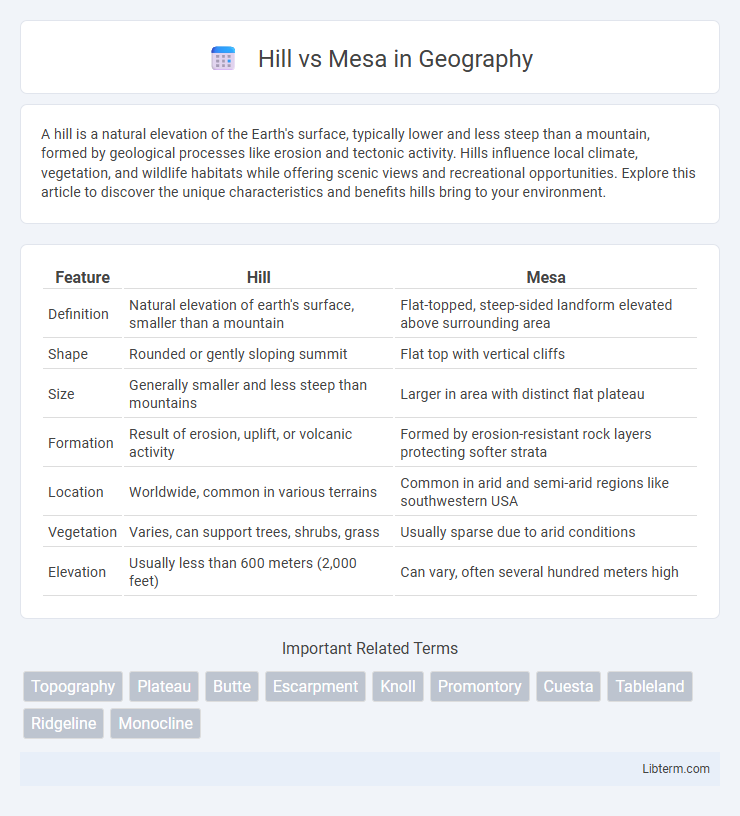A hill is a natural elevation of the Earth's surface, typically lower and less steep than a mountain, formed by geological processes like erosion and tectonic activity. Hills influence local climate, vegetation, and wildlife habitats while offering scenic views and recreational opportunities. Explore this article to discover the unique characteristics and benefits hills bring to your environment.
Table of Comparison
| Feature | Hill | Mesa |
|---|---|---|
| Definition | Natural elevation of earth's surface, smaller than a mountain | Flat-topped, steep-sided landform elevated above surrounding area |
| Shape | Rounded or gently sloping summit | Flat top with vertical cliffs |
| Size | Generally smaller and less steep than mountains | Larger in area with distinct flat plateau |
| Formation | Result of erosion, uplift, or volcanic activity | Formed by erosion-resistant rock layers protecting softer strata |
| Location | Worldwide, common in various terrains | Common in arid and semi-arid regions like southwestern USA |
| Vegetation | Varies, can support trees, shrubs, grass | Usually sparse due to arid conditions |
| Elevation | Usually less than 600 meters (2,000 feet) | Can vary, often several hundred meters high |
Understanding the Basics: What is a Hill?
A hill is a naturally elevated landform that rises above the surrounding terrain, typically characterized by a rounded summit and moderate slopes, distinguishing it from steeper mountains. Hills vary in height but generally have an elevation less than 600 meters (approximately 2,000 feet), making them lower and less rugged than mountains. Understanding the nature of a hill involves recognizing its formation through geological processes such as erosion, sediment accumulation, or tectonic activity, which contribute to its distinct shape in contrast to other landforms like mesas.
Defining a Mesa: Key Characteristics
A mesa is a flat-topped elevated landform with steep, often vertical, sides formed by resistant rock layers that withstand erosion better than surrounding materials. Its distinctive plate-like shape typically results from differential weathering, where softer rocks erode away, leaving the harder caprock intact. Mesas are commonly found in arid and semi-arid regions, characterized by their broad, level summits and isolated, table-like appearance.
Formation Processes: Hill vs Mesa
Hills form through long-term erosion and weathering that gradually wears down elevated land, resulting in rounded or gently sloping landscapes. Mesas develop from resistant rock layers protecting underlying softer strata from erosion, leading to flat-topped hills with steep cliffs. The formation of mesas is often linked to arid or semi-arid climates where differential erosion creates stark, isolated plateaus.
Geological Composition Differences
Hill and Mesa formations differ significantly in their geological composition, with Hills primarily composed of resistant rock types such as granite or basalt that withstand erosion over time. Mesas are typically characterized by a layered sedimentary structure, often including sandstone, shale, and limestone that create steep, flat-topped features. The erosion resistance of the caprock on a mesa's summit is crucial in maintaining its distinct shape compared to the more uniformly eroded slopes of hills.
Visual Identification: Spotting Hills and Mesas
Hills and mesas differ primarily in their visual identification; hills are elevated landforms with gently sloping sides and rounded summits, whereas mesas feature flat tops and steep, often vertical, cliff-like sides. Mesas are typically wider than tall, formed by erosion-resistant rock layers that preserve their plateau-like shape, while hills have more uniform slopes composed of softer geological materials. Recognizing these visual traits helps in distinguishing mesas from hills in various terrains, contributing to accurate topographic analysis and mapping.
Ecological Distinctions between Hills and Mesas
Hills and mesas exhibit distinct ecological characteristics influenced by their topography and soil composition. Hills typically support diverse vegetation due to gradual slopes and richer soil accumulation, fostering habitats with varying microclimates and moisture levels. In contrast, mesas, characterized by flat-topped surfaces and steep cliffs, often host specialized, drought-resistant flora adapted to shallow, nutrient-poor soils and harsher environmental conditions.
Historical and Cultural Significance
Hill v. Mesa represents a landmark legal case that deeply impacted voting rights and electoral fairness in the United States. The case underscored systemic issues of racial gerrymandering and voter suppression, highlighting the ongoing struggle for equal political representation. Its historical significance lies in influencing reforms and raising public awareness about the cultural importance of protecting democratic participation for marginalized communities.
Notable Examples Around the World
Hill vs Mesa is a landmark case that illustrates the complexities of property law when defining boundaries between adjacent landowners. Notable examples around the world include the English case of Sturges v Bridgman, which established principles of nuisance and boundary rights, and the Australian case of Hunter Valley Developments Pty Ltd v Cohen, emphasizing the importance of clear property demarcations. These cases highlight judicial approaches to resolving disputes involving land shapes and boundaries, impacting global property legislation and land-use strategies.
Recreational Uses and Tourism
Hill and Mesa offer distinct recreational opportunities, attracting diverse tourism profiles. Hill features extensive hiking trails and scenic overlooks, ideal for nature enthusiasts and photographers seeking panoramic vistas. Mesa provides unique rock climbing spots and off-road biking routes, drawing adventure tourists and outdoor sports aficionados year-round.
Hill vs Mesa: Which Dominates Your Local Landscape?
Hill and Mesa represent two distinct geological formations that dominate local landscapes through their unique structures and ecological impacts. Hills are typically smaller elevations with gentle slopes, fostering diverse vegetation and human settlements, while mesas are characterized by flat-topped, steep sides formed by erosion-resistant rock layers, creating dramatic natural landmarks. Understanding the dominance of Hill vs Mesa in a specific area depends on factors like regional geology, climate, and human activity, influencing land use, biodiversity, and tourism potential.
Hill Infographic

 libterm.com
libterm.com